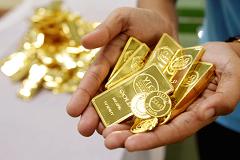Demand for physical gold jumps 53% in second quarter
Global consumers aggressively ramped up purchases of physical gold in the April-June period, led by opportunistic buyers in emerging markets at a time when the precious metal suffered a record quarterly loss, the World Gold Council (WGC) said on Thursday.
Consumers around the world bought 53 percent more bullion in the second quarter from the year ago period, bringing total purchases of gold jewelry, bar and coins to 1,083.2 metric tons, according to WGC's quarterly report on demand trends.
Of this, India accounted for the biggest share at 310 metric tons, which is a 71 percent rise from the same period a year earlier, followed by China at 275.7 metric tons, marking an 87 percent increase.
(Read more:
Bullion's speculative trade near its end: World Gold Council)
"Bar and coin demand in China is at an all-time high, while demand for jewelry is up more than 50 percent compared to a year ago. This strong appetite for gold jewelry could be considered unusual as the second quarter is traditionally a slow season, following the peak around the Chinese New Year," Albert Cheng, managing director, Far East, WGC, an industry body representing gold miners, said.
"Given that Chinese investors have traditionally bought gold when the price is rising, this level of demand in a falling price environment suggests that Chinese consumers' confidence in gold remains strong in the long term, underpinned by the lackluster performance in other investible assets," he said.
Last month, the organization said it expects China to overtake India as the world's top bullion consumer this year as New Delhi steps up restrictions to curb gold imports.
But overall demand for the precious metal, which includes purchases of gold exchange traded funds (ETF) and physical gold, fell an annualized 12 percent in the second quarter to 856.3 metric tons, the report showed. This is due to the heavy selloff in gold ETFs - which accelerated to 402.2 metric tons in the quarter from 176.5 metric tons in January-March quarter - that countered buying in physical gold.
(Read more:
Investing pros look East for signs of gold rebound)
Low inflation levels, expectations for the U.S. Federal Reserve to withdraw liquidity and the subsequent rise in U.S. Treasury yields have driven hedge funds and speculative investors to exit their positions in gold in the recent months.
Billionaire investor John Paulson, for example, more than halved his stake in SPDR Gold Trust, the world's biggest gold ETF, in the second quarter, Reuters reported on Thursday.
Buying by central banks also slowed significantly, WGC said. While they remained net buyers of gold in the second quarter, central banks purchased just 71.1 metric tons, down from 109.7 metric tons in first quarter of 2013 and 164.5 metric tons from year-ago levels. Buying was concentrated among countries in the Commonwealth of Independent States (CIS) countries, including Russia, which was the largest buyer at 15 tons.
(Read more:
Is sentiment toward gold shifting again?)
WGC cites volatile price moves, weakness in emerging market currencies and the declining rate of foreign exchange reserves at some central banks as reasons behind the cooling demand for gold.
Yet, the organization said it expects central banks to remain net buyers of gold, forecasting a b annual demand of between 300-350 metric tons, in line with the average for the last three years, it said.
(Read more:
Gold is a trading affair, so here's how to trade it)
"The fundamental arguments for central bank buying remain in place; allocations to gold are still largely far below 'optimal' in many emerging markets, and the desire to diversify away from an over-dependence on the U.S. dollar continues at many central banks," WGC said.
óBy CNBC's Ansuya Harjani; Follow her on Twitter
@Ansuya_H
© 2013 CNBC LLC. All Rights Reserved.

